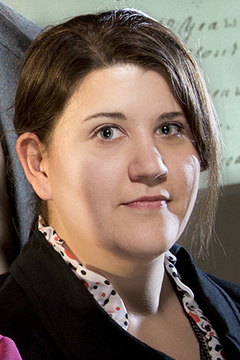
A little more than 150 years ago, black soldiers took up arms with the Union to fight in the Civil War when the first regiments of African-American troops were authorized in the North in 1863. As they enlisted, words of support poured out from Union-sympathizing newspapers everywhere, and much of the support came in the form of poems. Fanny Jackson, an African-American student at Oberlin College, began:
We welcome, we welcome, our brave volunteers,
Fling your caps to the breeze, boys, and give them three cheers;
They have proven their valor by many a scar,
But their god-like endurance has been nobler by far.
-"The Black Volunteers," printed May 9, 1863, in The Anglo-African
Now, an edition of these and other Civil War-era poems is available online, complete with images from the newspapers in which they appeared and with historical and literary analysis that provides insight into the role of newspapers and poetry during the Civil War.
The edition, co-edited by UNL English research assistant professor Elizabeth Lorang and Rebecca Weir, supervisor in American literature at the University of Cambridge, was published in the 2013 volume of Scholarly Editing, an open-access online journal. It is available at http://go.unl.edu/afy.
Hundreds of thousands of poems appeared in newspapers across the nation during the war. The poems included in the newly published edition were chosen because of the proximity of the two newspapers that published them and for their emphasis on military service, citizenship, race and gender.
The newspapers were written for two distinct audiences: The National Anti-Slavery Standard was published for a white abolitionist audience, while The Anglo-African was for a black audience. The Anglo-African was one of the most important African American newspapers in the Civil War era, but it has received little attention in the years since.
Weir noticed that the newspapers, neighbors on New York's Beekman Street for a time during the war, printed many of the same poems.
“One of the great finds we’ve made is that it appears there was a heretofore unacknowledged but remarkable collaboration between the two newspapers,” Lorang said. "What's unique about this edition is the focus on the relationships between two Civil War publications. It's the first edition of its kind."
Lorang and Weir identified and researched a selection of 138 poems, about a quarter of the poems published by the two newspapers. Most were published from May 1863 to May 1864, a period that saw a great number of African-American men enlist in the Union Army and distinguish themselves as soldiers in spite of the War Department's prejudiced policies. Many of the poems encourage enlistment, praise the soldiers and show authors negotiating the public meaning of African-American military service.
Lorang and Weir were able to identify many of the authors and their historical significance. One poem is by William Slade, a black assistant to President Lincoln who was featured in the 2012 motion picture “Lincoln.” Slade had not previously been acknowledged as a poet, and Lorang and Weir said they were eager to see what else he may have written.
While conducting research, Weir said she was struck by how little of the verse had featured in critical conversations about African-American and Civil War literature.
"This is especially true of poems that editors borrowed from other newspapers," she said. "Reprinted poems in the edition help us to see that editors made meaningful choices, fitting words to the moment."
Lorang said the poems and newspapers have parallels to the modern world; she likened the poems and their historical context to the social media outlets citizens use today. Rather than posting to Facebook or Twitter, 19th-century authors of the poems took their ideas to the masses through newsprint.
“How a culture gets through war is very relevant right now; sadly it's seemingly always relevant,” she said. "Poetry was and remains one of the ways we process the experience of war on both individual and social levels."
-- Deann Gayman, University Communications
More details at: http://go.unl.edu/afy